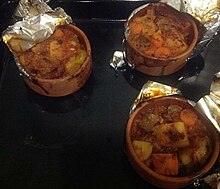Ghivetch

Ghivetch (
Origins
Ghivetch is known throughout the Balkans as a traditional autumn vegetable stew, but it is most closely associated with Romania and Bulgaria.[1][2] It is a national dish of Romania, where it is called ghiveci.[3] It is a dish eaten by Danube Swabians.[4]
Ingredients
Ghivetch is often made only with vegetables, sometimes as many as 40, but versions exist that include meat, fish, poultry and dairy.[1][2] In the Western Balkans it is often consumed with rice.
Preparation and serving
Traditionally the stew is prepared in a clay pot called a güveç, duvech,[5] or gyuvech;[citation needed] in Greece the pot is called yiouvetsi.[5] According to Paula Wolfert the pot is "beloved for its ability to impart a great earthy taste and aroma".[5] Traditionally the dish is assembled at home, then taken to a local bakery, and delivered to the customer by a delivery boy wearing a cushion on his head.[5] Truck delivery has replaced the delivery boys.[5] Some specialty bakeries allow customers to order ghivetch to be assembled by the bakery rather than by the customer at home; customers return the empty pot to the bakery.[5]
Ghivetch can be served hot or cold.[2] It is sometimes pureed.[2] It is often garnished with sour cream or yogurt.[2]
Importance
The Washington Post in 1985 called it "one of the world's great vegetable melanges", along with Buddha's delight, ratatouille, and moussaka.[1] The New York Times in 1977 specifically distinguished it as one of the mixed-vegetable stews characteristic of various cuisines.[6] Sheraton called it "really the last word in vegetable stews" and included it in her book 1000 Foods to Eat Before You Die.[6][7]
Related dishes
Other mixed-vegetable dishes
- Buddha's delight
- Lecsó
- Leipziger allerlei
- Locro de choclo[2][6]
- Maque choux
- Moussaka
- Pinakbet
- Succotash
- Ratatouille
- Peperonata
References
- ^ ISSN 0190-8286. Retrieved 10 January 2022.
- ^ ISSN 0099-9660. Retrieved 10 January 2022.
- ISSN 0362-4331. Retrieved 2022-01-11.
- ^ "Juwetsch with Beef by Tina Leto | Cooking Donauschwaben Style!". www.dvhh.org. Retrieved 2023-09-15.
- ^ )
- ^ New York Times. 22 June 1977.
- ISSN 0099-9660. Retrieved 10 January 2022.
